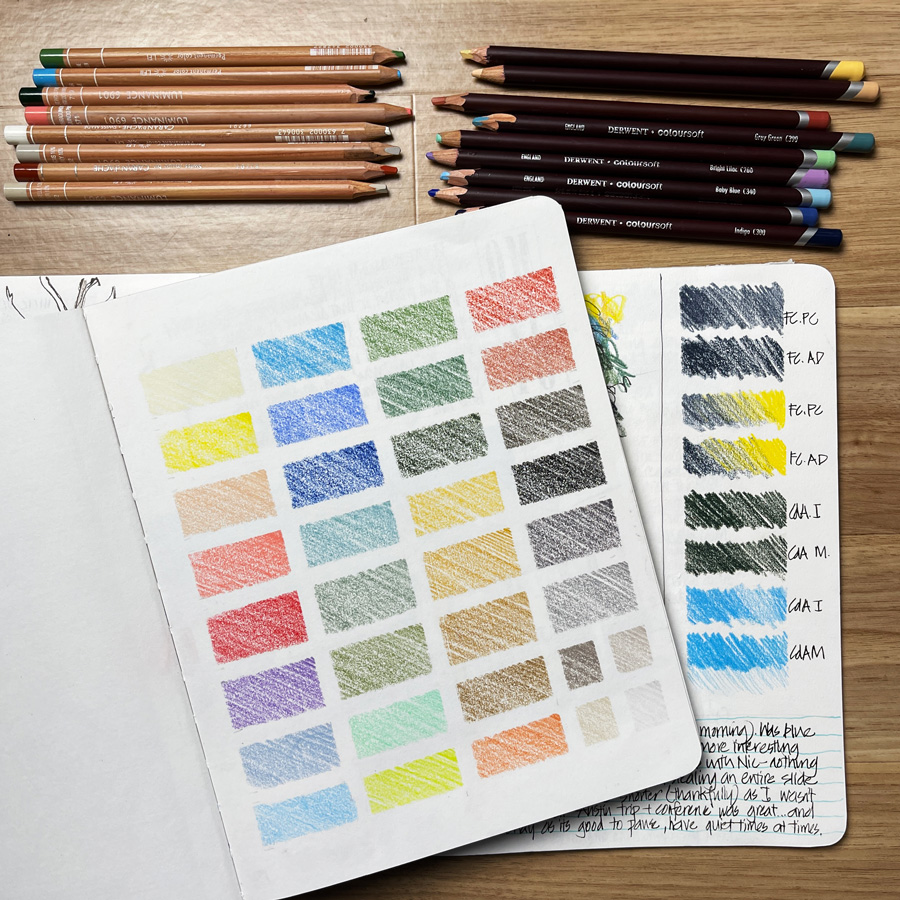
I have a lot of sketchbook pages to scan from the last two weeks, but before I do that, I want to share some thoughts about my coloured pencil journey so far.
I’m doing this mainly for my own record as a way of documenting my personal exploration of using coloured pencils so it’s not intended as an instructional article as such! But I hope that you will find something that will be useful for your own sketching. If you are someone who has used coloured pencils a lot in the past, I’d love to hear your tips and preferences in the comments section below. I’m still very much in an intensive learning mode!
And BTW, it’s nearly 3 weeks since I touched my watercolour paints and I haven’t been missing them as much as I expected! This is definitely not a permanent change of media but to get the most out of the experience I want to finish my current sketchbook using coloured pencils exclusively (another 2 weeks’ worth of sketching).
Current Selection
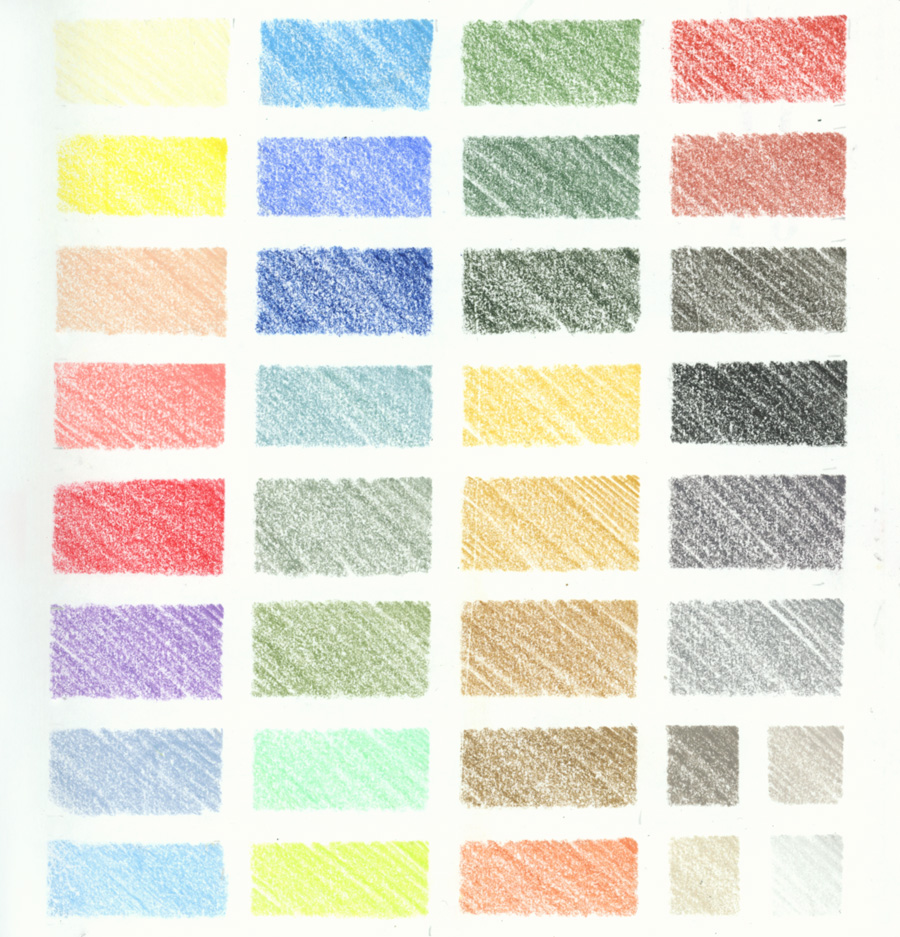
In just over a week, I managed to put together a selection of coloured pencils that I was happy with and then I started getting to know them individually and how they worked together. Getting to know the colours by name was easier than I expected, but I’m still experimenting with ways of layering the different colours. Note: I’m intentionally not sharing the colours as it will change and I don’t want anyone to blindly go out and buy exactly what I’m using.:-)
My current selection contains around 36 pencils which is more than I would like to carry around… but there are just so many nice colours – particularly in the pastel shades!
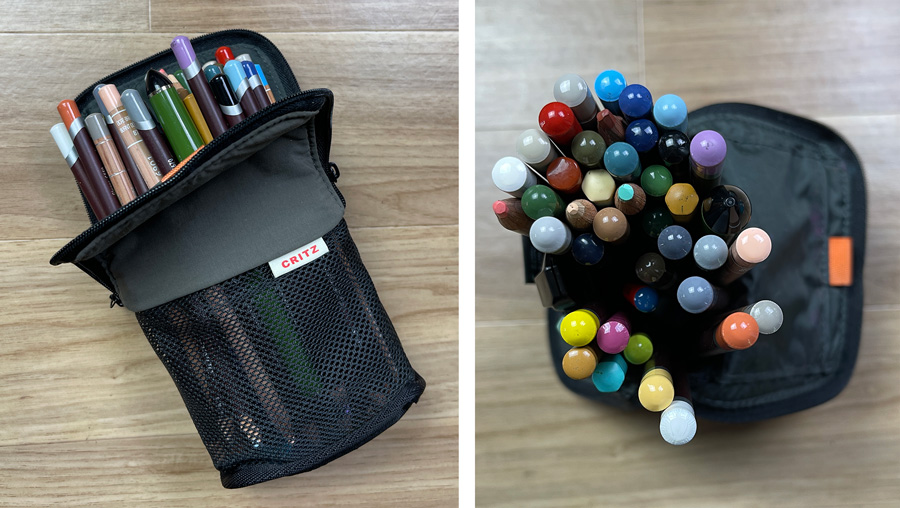
This is the pencil case that I’m using (purchased from Larrypost but currently out of stock) and it comfortably fits all these pencils plus a pen or two. There is room for a few more pencils but I can’t go crazy and expand my collection too much!
What about watercolour pencils?
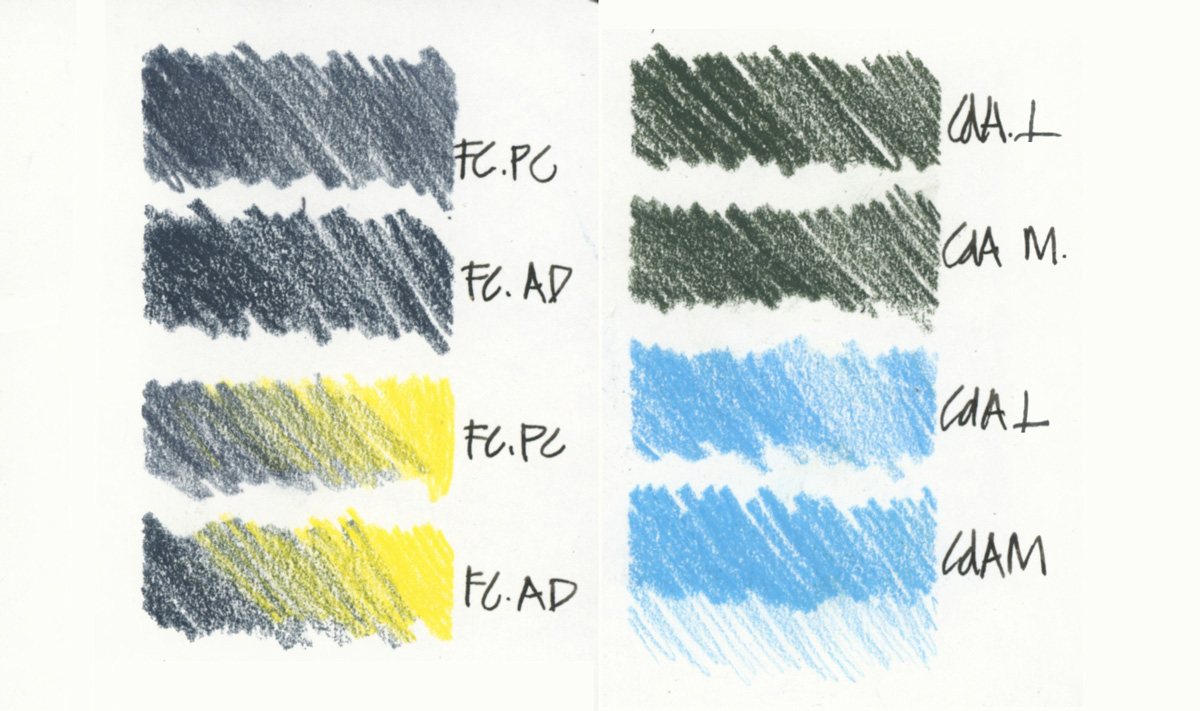
A few people have asked about using Watercolour Pencils (WCP) dry – without adding water – instead of Coloured Pencils (wax or oil-based). As mentioned in my last article, I don’t want to have the temptation to add water at the moment so I’ve decided to use coloured pencils for now. However, I wanted to see how they differ in a dry state.
I did this quick test to compare Faber Castell Polychromos (oil-based) vs Albrecht Durer (WCP) and Caran d’ache Luminance (wax-based) vs Museum (WCP). In both cases the WCP was softer and stronger – this was quite noticeable with the Faber Castell pencils.
My guess is that the WCPs might not layer as well as the CPs if you are working realistically with many layers (if you have experience with this I would love to know for sure) but as I want to develop a quick loose approach for my pencil sketches I don’t think there would be a huge difference. But of course, I’m just in the early stages of this journey so I expect to have a greater understanding of the different brands down the track.
Using coloured pencils in a sketchbook
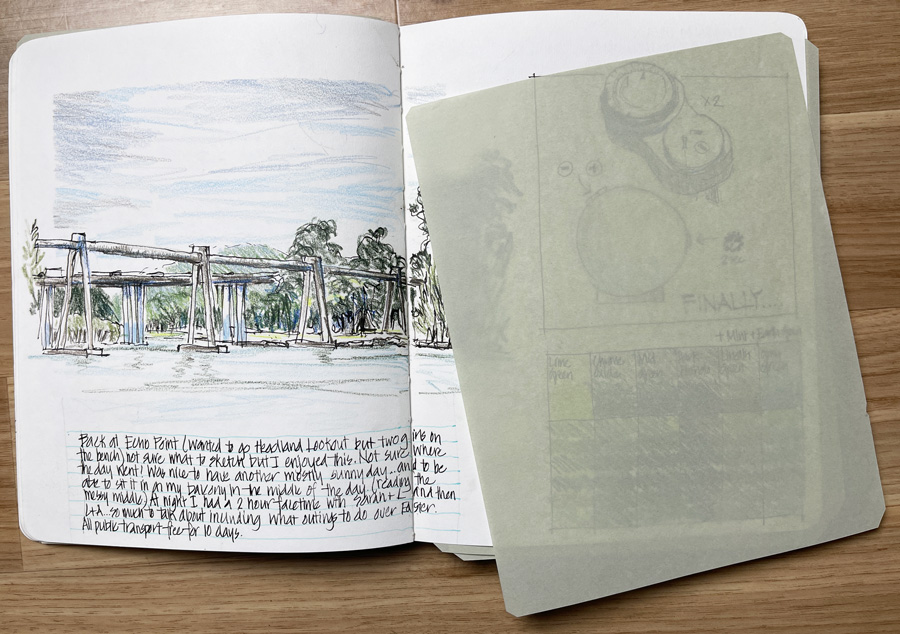
While I am loving not having any buckling in my sketchbook at all ( generally I don’t mind a little buckling but it’s nice not to have any at all in an Alpha book) I am interleaving my spreads with some loose paper trimmed down to the size of the book (it’s just some thin paper I found in my cupboard). This reduces smudging/ transferring onto the opposite page and is working fine for me.
I also recently bought some workable fixative and have sprayed a few pages with it to see how it performs. If you have any comments on the best brand or any problems with using fixative in a sketchbook I would love to hear them in the comments below.
Subject Matter
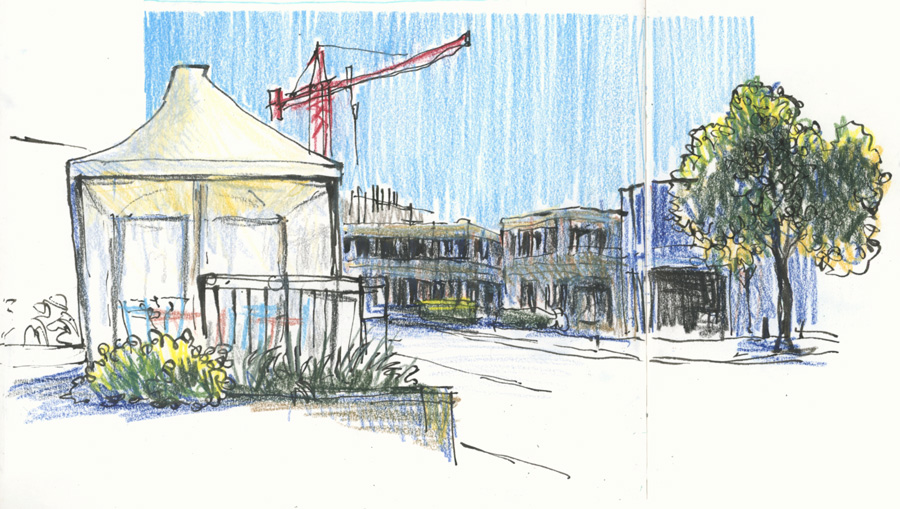
As mentioned in my last article I’ve been really enjoying sketching complex scenes with coloured pencils – particularly when I work small.
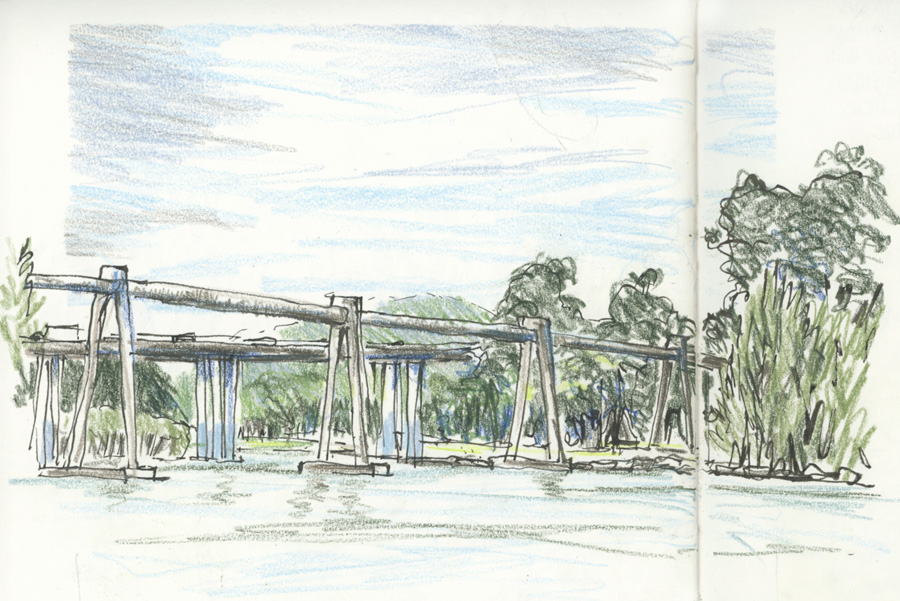
This is another example – the view of Roseville Bridge from Echo Point – drawn at about the same size (24 x 12cm). At this scale, there are only a few large areas (foreground and sky) and the rest of the subject matter easily able to be covered with coloured pencils quickly.
On the other hand, I haven’t yet found an approach for objects or more zoomed-in scenes where there are plain surfaces. I’ve always had a somewhat messy approach to colouring in, so the traditional approach of doing multiple layers of even shading is not in my style.
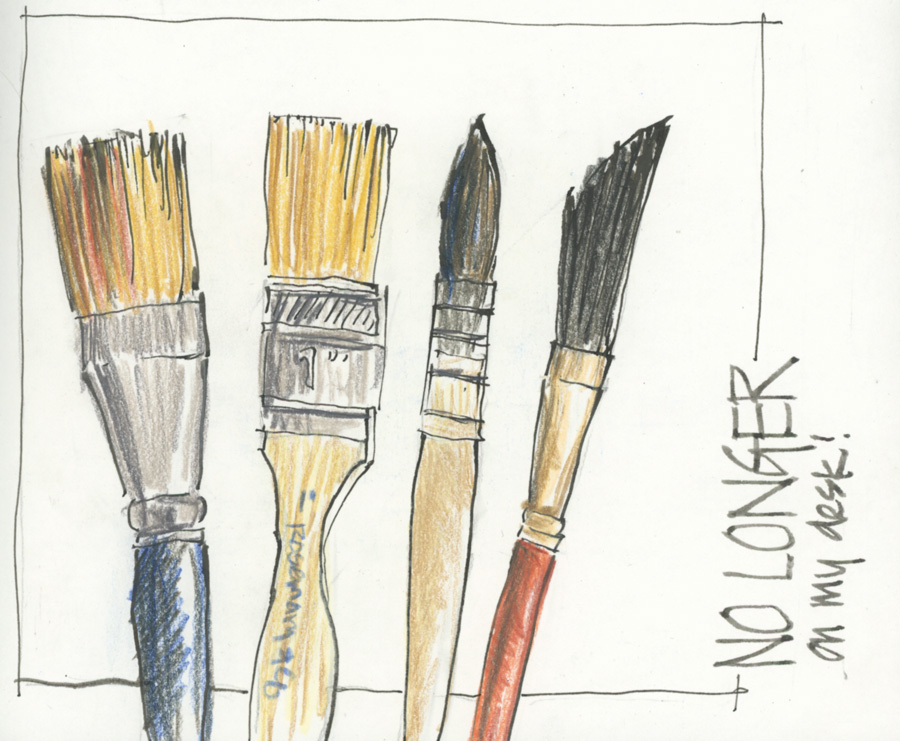
If the objects have texture and only small areas of plain surfaces, I’m much happier doing them with coloured pencils.
I’m also finding it harder when I work larger out on location as I then feel compelled to include lots of texture. This is a quick rough late afternoon sketch of a local church – expressing the brickwork is SO out of character! Ha!
Just for the record… not all of my coloured pencil sketches at the moment are successful. You will see the full collection later in the week when I share the full spreads from my sketchbook.
As I’ve been reviewing these thoughts I’ve come to an interesting conclusion:
At the moment, I’m finding that working small, sketching complex scenes or subjects with lots of texture are the best for coloured pencils. I still have to find a technique for larger sketches and/or ones with plain surfaces. This is opposite to my preference when I work in watercolour – I love zooming in, working larger and adding watercolour texture/variety to plain surfaces and find doing small complex scenes in watercolour more of a challenge (unless I really simplify). So it seems that using coloured pencils could complement watercolour sketching well.
Books
I’ve been researching a number of books too!
Most coloured pencil books are geared towards multi-layered realistic work but this book by Judy Martin does have a number of examples of loose sketches.
As I continued going through my library I suddenly thought that it would be good to check out a few graphite pencil books, realising that these are probably more relevant to the way I want to use CPs.
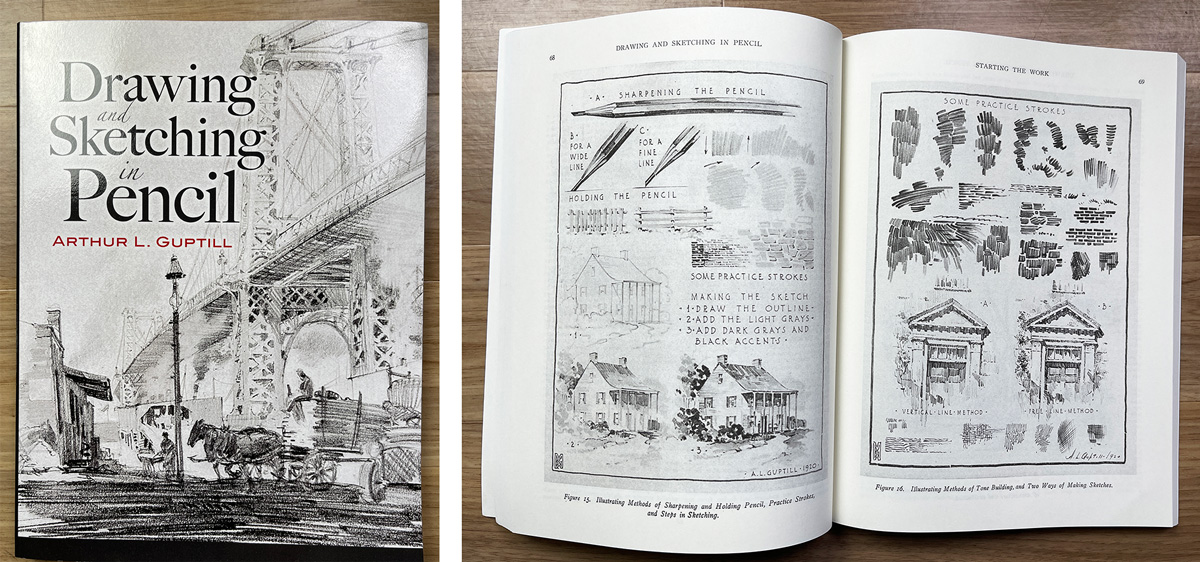
So of course I pulled out this classic book by Arthur Guptill…

… and also this favourite by Jack Hamm. (Aside: This was one of the first instructional books I bought when I first started sketching in late 2007.)
Both of these graphite pencil books emphasise deliberate strong marks with a chiselled pencil point.
To date, I’ve not done this much as I’ve mainly been adding colour to ink drawings.
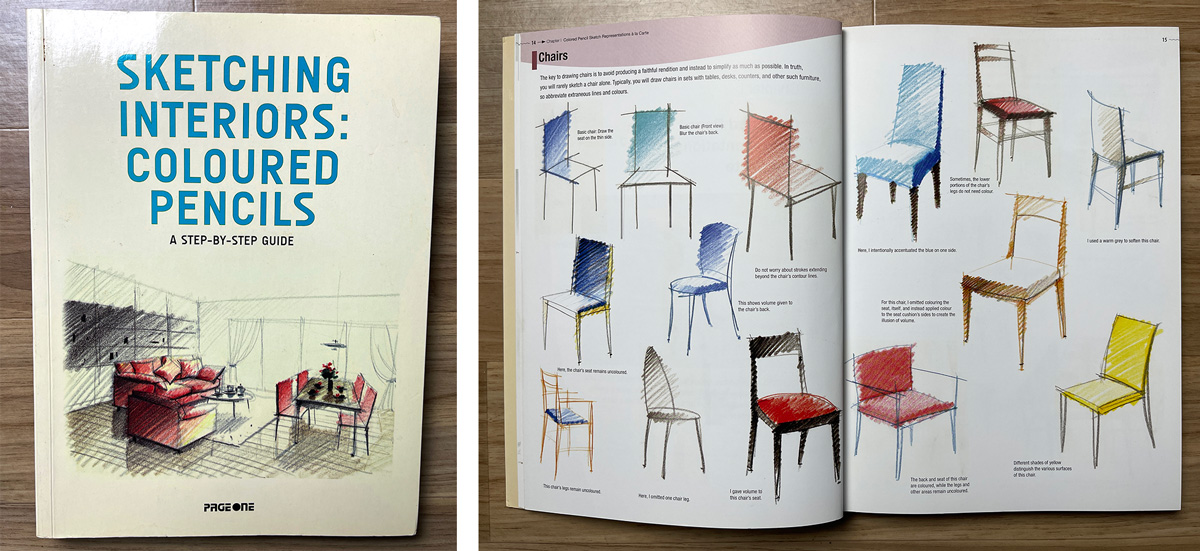
I also came across this book (by Noriyoshi Hasegawa) from my days working as an architect. It describes a technique of very rapid diagonal hatching that doesn’t stay within the lines. I was more interested in markers at the time so didn’t really use this much.
It has lots of different interior examples and some fun floor plans. It demonstrates a really cool way of using coloured pencils in a rapid sketchy way. I like this style a lot but not sure how easy it would be to incorporate into my sketching with lots of different subject matter. The most important aspect of revisiting this book now is reminding me of leaving lots of white space. For some reason, I haven’t done much of that so far in my own coloured pencil sketches.
Only pencil and heavier texture
I’ve spent most of the last two weeks simply getting to know my pencils and establishing a way of using them for sketching at home and out on location. And as mentioned above, most of my work has started with an ink drawing and then applying the coloured pencils.
But in the last few days, I’ve been making a more concerted effort to draw and colour with pencils and not use ink at all!
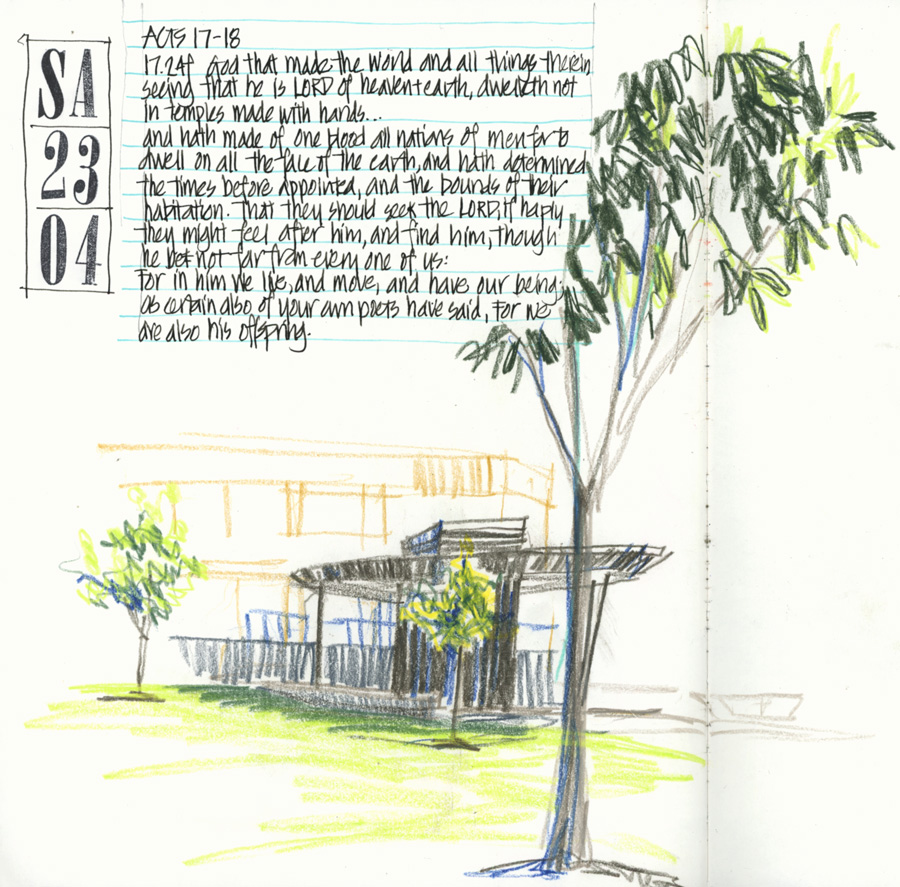
I was really inspired by some recent work of Maru Godas and this fun illustrative use of coloured pencils is what I want to try next!
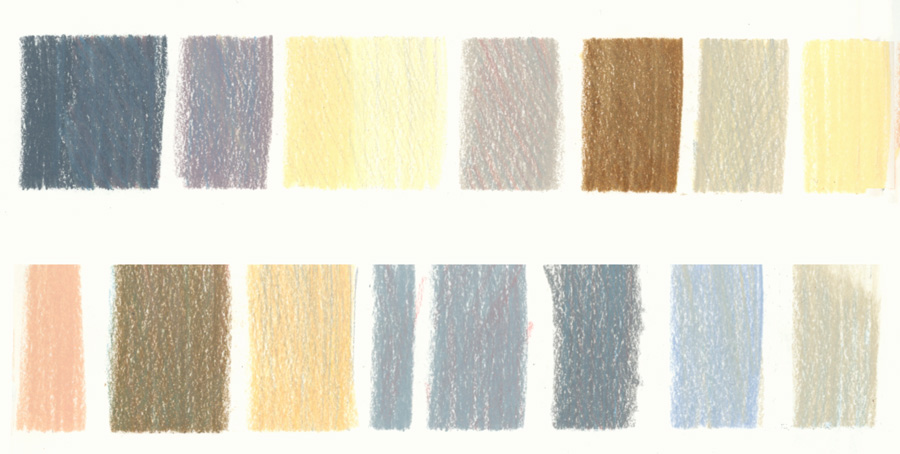
I’ve also been thinking of using heavier pressure and experimenting with solid blocks of colours.
Ah! there is so much still to explore and I’m loving every minute of this coloured pencil journey!

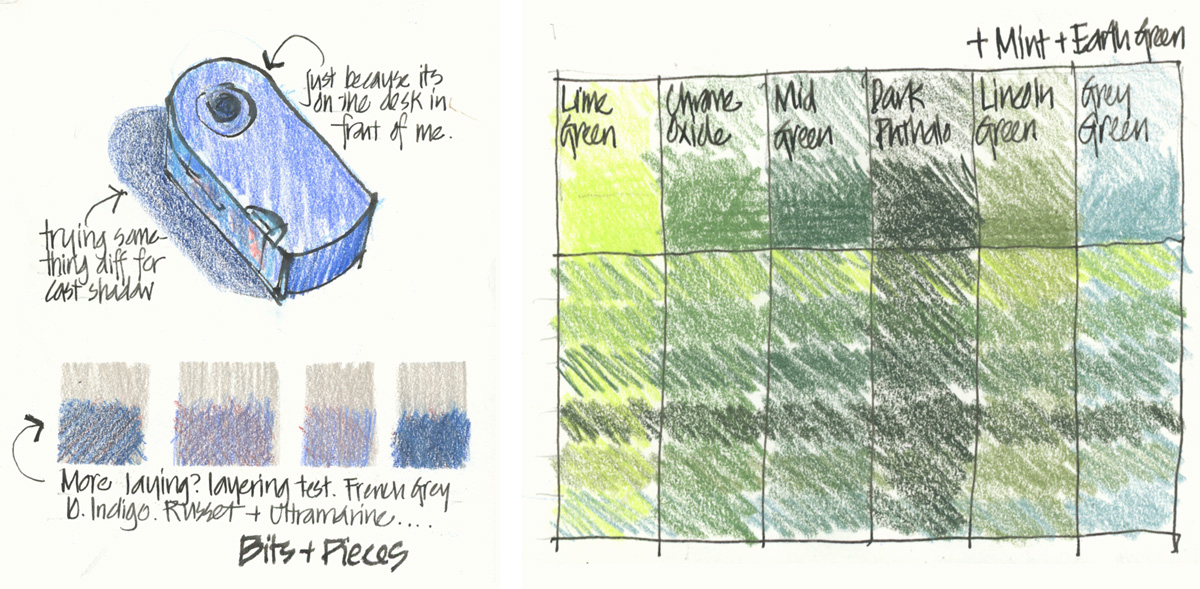
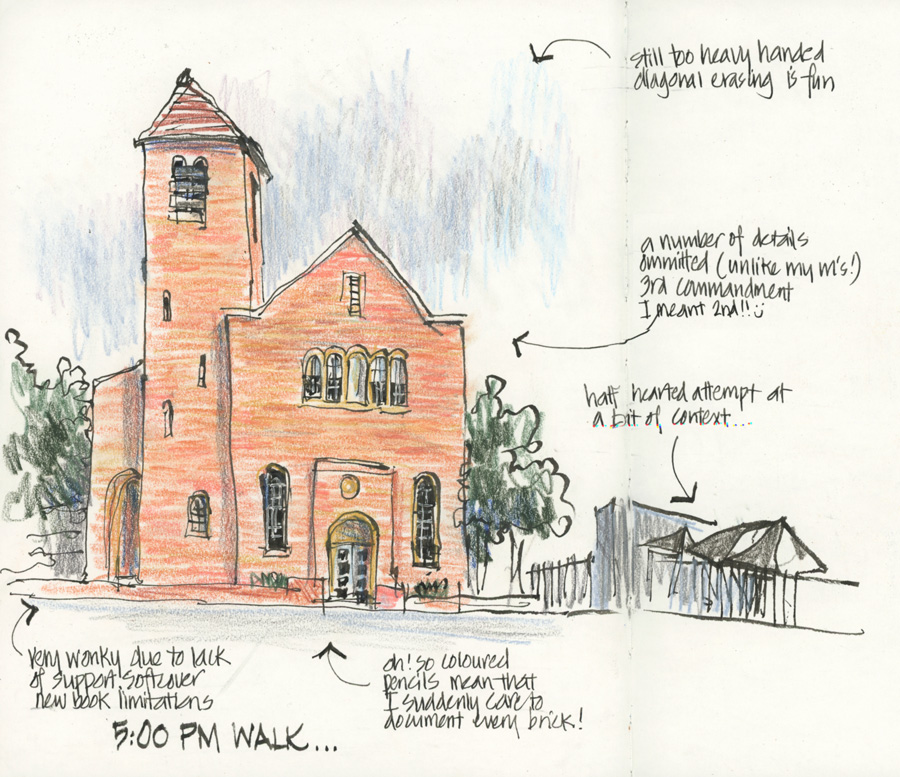
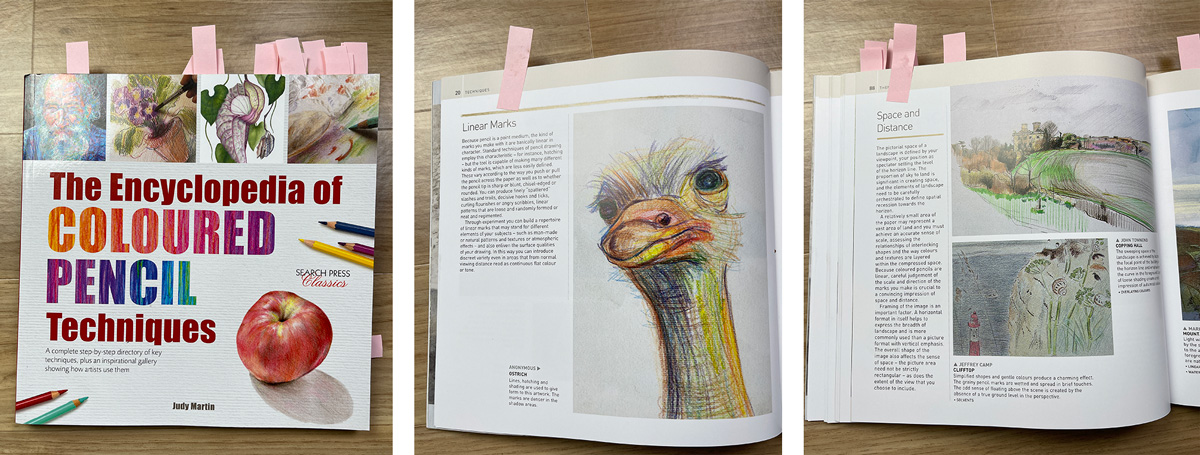
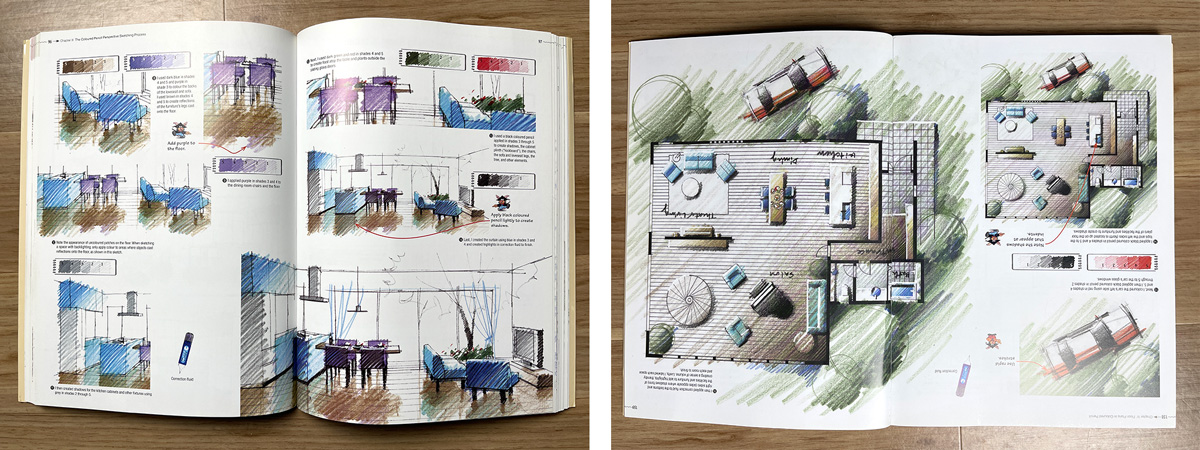
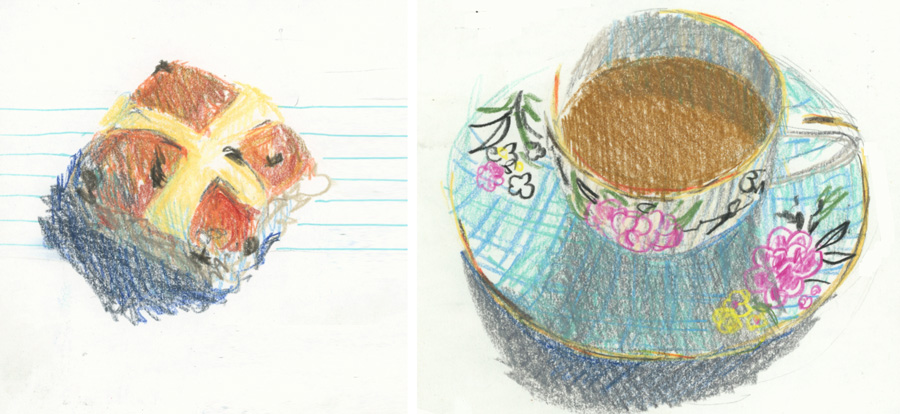



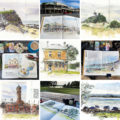
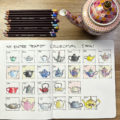
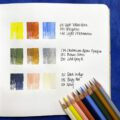
24 Comments
I’m Enjoying your colored pencil journey so much, Liz. FYI, as you explore making heavier and denser mark making be very conscious of the possibilities of repetitive use injuries. At the end of a 10 week intensive class using colored pencils, I experienced the telltale signs of carpal tunnel syndrome. Since I noticed that you were wearing some sort of wrist support (quite awhile ago), I wanted to pass this concern along.
Hi Dana – yes! I’m super aware of this issue and actively doing stretching exercises during our after heavy pressure work.
Thank you Liz for your learning share!
I wanted to give you a tip when drawing with colored pencils in a notebook: Put behind the page on which you draw a cardboard sheet a little thick. I use an alpha notebook like you, and I find that this cardboard makes it easier to color because the support is harder. In addition, we do not make traces of pencils on the page below 🙂
Hi Laurence – thanks for that tip – will get some cardboard and try it out!
Liz: Glad to be tagging along on your discovery journey! I use mostly Prismacolor pencils but also love Inktense wc pencils. Sometimes I will use the Prismas to add just a little more detail or shading or color correction, dimension to my watercolor sketches once they are thoroughly dry. Lightly skimming the surface gives wonderful color variations. Fun to add various effects and Prismacolors will go over anything but then the waxy surface may thwart your efforts with any further watercolors or inks. Enjoy!
Thanks for sharing Lisa and yes! I’m looking forward to combining CP and watercolour in a week or so. BTW I’m super interested to explore CP as resist under watercolour 🙂 Actually thinking about watercolour texture was the reason I got my CPs out! 🙂
I’m enjoying your colored pencil explorations! I’ve been using colored pencils (mostly watercolor pencils) as my exclusive color medium for several years now. One thing you might want to try is a paper with a stronger tooth than Alpha. I like to let the paper’s tooth help with texture, especially for trees/foliage. If you are using a harder pencil (like Polychromos), you can still get a relatively solid application on the same toothy paper. I have lately been using a Hahnemuhle watercolor book that has a stronger tooth than Alpha/Beta, and I’m really enjoying it.
Hi Tina – Thanks for comment…I will be using Moleskine soon so that will be a good chance to use some paper with more tooth. 🙂
I’m watching this closely. I’ve only been working w wc for 14 mos. I love it. But there is something so clean & simple about using pencils. I bought the Caran D’Ache sets a few months ago but not much progres until I found your blog. So I will be following your journey closely. It’s always exciting and daunting to start a new project. My Daniel Smith isn’t going anywhere while I go off to explore. I’m jumping in with both feet.
Hi Linda – totally agree with your phrase ‘clean & simple’ and pencil sketches always have beautiful colour. All the best for your CP and watercolour journey!
Hi, Liz! I am inspired by your posts about colored pencils and I like the way you use them. My set for sketching on location is usually about 20 colours that vary a little dependent on the season. Tip for covering larger areas: sharpen the pencil with a pencil sharpener and use it flat, drawing with the side of the core, not with the tip. Or just use watercolours for background 😉 – they give a very nice tooth once they are dry, I like a lot drawing with CP over a watercolour layer.
Hi Dora, thanks for comment and yes, I’m starting to use the pencil tip on the side more often these days. And yes, ultimately I will be incorporating CPs with watercolour and that will solve this problem.
I’m taking a class on line using water color pencils. Do you use any water brush with your drawings? I do like the effect you get with the strokes.
Hi Sofia – I’m only using coloured pencils (not water-soluble ones) so no water! You can see my WCP work here:
https://www.lizsteel.com/tag/watercolour-pencils/
Hmmm
I dislike colored pencils because they feel like I can color and color and blend and blend and all I want is the instant gratification of saturated color. Breathe! Lol
I’ve tried color pencils in my sketchbook. Like regular graphite pencils, the pages rub against each other. I get color transfer to what was a clean page and less saturated color where color was intended.
I’m Not going to add tissue paper between pages.
My sketchbooks for years are ink or watercolor. Ink only for the last year.
I’m wondering how you’re going to find the color pencil sketchbooks in the future? Will the colors have transferred like graphite pencils?
I was curious about your experiments with pencils. I used them so often as an architect that I am pretty proficient wiht them but find them unsatisfying… I occasionally used them over watercolors or liquid shellac inks.
For years I’ve often interleaved my spreads with paper trimmed to the size of the book, unless I have only written on the facing page in a waterproof ink. I hate the transfer of mediums from one page to another, always have. If it is a two-page spread I get inventive about how to secure the addition but I always do it unless the sketches are really experiments, not sketches.
I hate workable fixative. Again, used it as an architect. Besides the toxicity to the environment, I don’t like how the they change the color and texture.
Thanks for sharing Kate!
You may find this strange but I have used pencils for a long time. I draw very little and not well but just love to color. Use both oil and wax..like oil best. Have friends who can draw things then I color them..love to color and shade especially flowers. Am now experimenting with pastel chalks and using oil pencils for further detail..what fun!
Very cool – thanks for sharing!
I use colored pencils for birthday cards I send my grandchildren. They are inexpensive Crayola colored pencils because I want to show my grandchildren and others that it does not have to cost much money to create items of beauty. These pencils are wax based. I use about a dozen colors and get all the inbetween colors by blending one on top of another.
As I have told some of the young people I know, I draw my own coloring books.
John
In life it is not how fast you run or how high you climb but how well you bounce.
Thanks for sharing John!
Playing in many different mediums can be a messy process, but it often produces amazing results. You can make the most of the tools and supplies you choose to use if you use the correct mixed-media sketchbook.
Your creative journey will get off to a wonderful start if you learn how different mediums react to various types of paper. This information will be useful if you’re looking for a sketchbook.
Late to the party here but thought I would pass on a tip from my art teacher friend. When I brought up the issue off coloured pencils rubbing against other pages and should I buy fixative, she suggested I try hairspray!!! Apparently when she was teaching (we’re both retired now) fixative was too expensive so they used hairspray in the classrooms.
I’m in Australia so I don’t know if you have the Elnet brand of hairspray. They have always made a purse size which I bought to try out and seems to work just fine.
Hope that helps 🙂
NEWSLETTER
Subscribe for first notification of workshop + online classes and more.